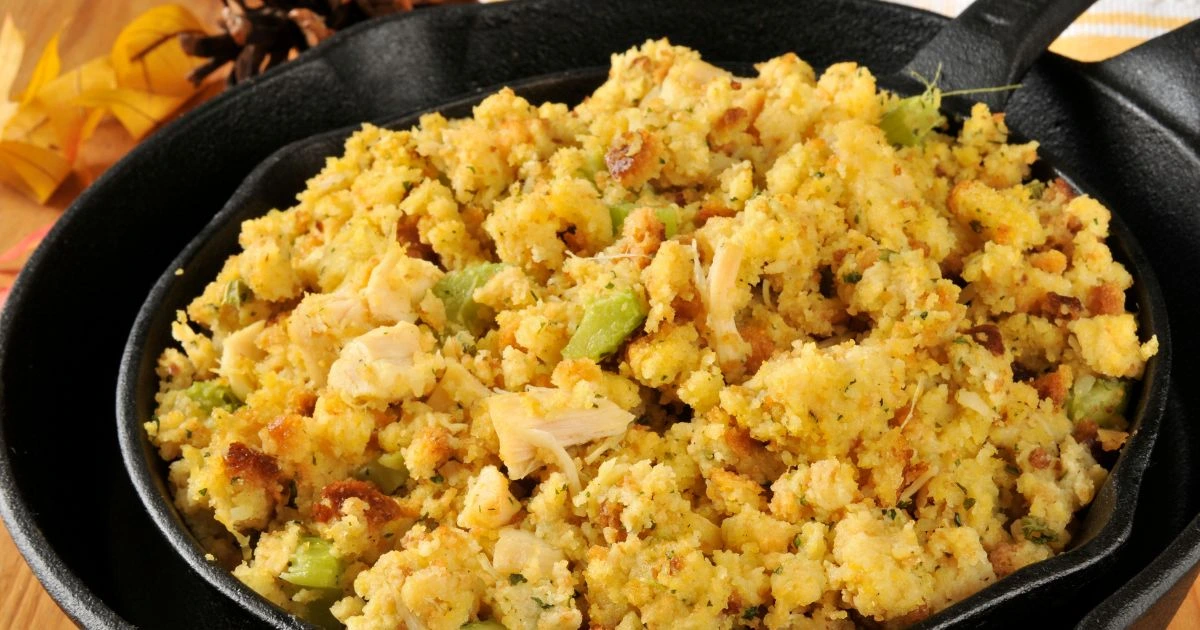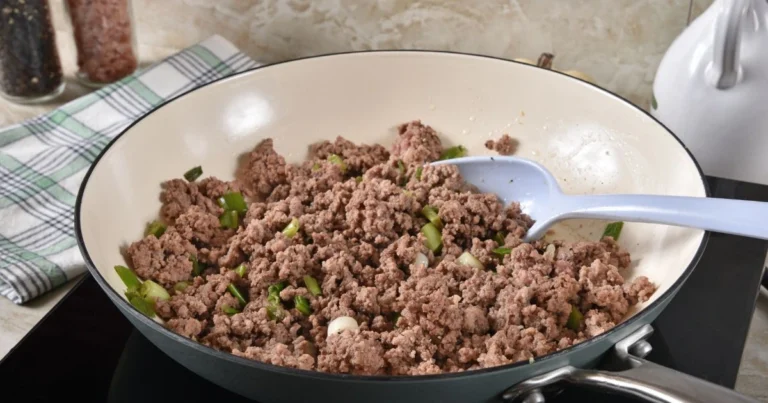Easy Cornbread Dressing with Chicken for Beginners

Table of Contents
Welcome to the world of Southern comfort cooking! This guide makes cornbread dressing with chicken easy for beginners. You’ll learn to make this classic dish with everyday ingredients. From picking the right cornbread to adding herbs, you’ll feel confident making this Thanksgiving favorite or a cozy weeknight meal.
Key Takeaways
- Step-by-step instructions for making cornbread dressing with chicken from scratch.
- Advice on choosing cornbread bases to suit your skill level.
- Flavor-enhancing techniques with herbs and seasonings.
- Pro tips to avoid common mistakes like uneven texture or bland taste.
- Flexible methods for using leftovers in creative ways.
What Makes Cornbread Dressing with Chicken a Thanksgiving Staple
Every Thanksgiving table tells a story, and cornbread dressing with chicken is often the star. It comes from Southern cooking, mixing tradition with flavor. This makes it a comforting and celebratory dish. Here’s why it should be on your menu this year.
The Southern Tradition of Cornbread Dressing
Southern cuisine loves cornbread, and chicken and dressing pairs it with savory protein. Unlike northern stuffings, this dish uses dried cornbread cubes, herbs, and poultry. It honors regional roots. Families pass down recipes, linking to heritage and community.
How Chicken Elevates the Classic Recipe
- Chicken adds protein, turning it from a side to a meal.
- Diced or shredded chicken adds texture contrasts with soft cornbread.
- Chicken broth deepens flavor without needing complex techniques.
Why It’s Perfect for First-Time Hosts
Hosting your first Thanksgiving can feel daunting. But this dish makes it easier. You can prep it days ahead, freeze parts, and it reheats perfectly. Even if timing slips, the forgiving recipe stays delicious. Guests will praise the effort, unaware of its simplicity.
Essential Ingredients for the Perfect Chicken and Dressing
Every great chicken dressing recipe begins with quality basics. Fresh ingredients make your homemade chicken and dressing special. Here’s what you need and why it’s important:
- Cornbread: Day-old bread is best for texture. Stale crumbs soak up broth better than fresh. Gluten-free cornbread is also an option.
- Chicken: Bone-in pieces add rich flavor. Choose plump, juicy thighs or breasts for tender bites.
- Aromatics: Onions and celery become sweet, savory layers. Garlic and bell peppers add depth.
- Liquids: Chicken broth keeps the mix moist. Use vegetable broth for vegetarian options.
- Eggs: Eggs bind the mixture without drying it out. Use 2-3 eggs, depending on cornbread amount.
| Category | Ingredients | Notes |
|---|---|---|
| Produce | Onions, celery, bell peppers | Choose crisp, firm vegetables |
| Pantry | Cornbread crumbs, broth, eggs | Keep cornbread stored airtight |
| Protein | Chicken thighs or breasts | Opt for skin-on for extra flavor |
Substitutions make it easier to meet dietary needs. Use almond milk instead of eggs for vegan homemade chicken and dressing. Always buy cornbread 1-2 days ahead to dry out properly. Quality is key: fresh herbs like sage or thyme enhance aroma, while stale bread affects texture. Plan your portions: 1.5 cups cubed cornbread per serving is ideal.
Choosing the Right Cornbread Base for Your Dressing
Every bite of cornbread dressing with chicken begins with the cornbread. The base’s texture and flavor are key. So, pick wisely. Whether you make it yourself or buy it, the choice affects the whole dish.
Homemade vs. Store-Bought Cornbread
Homemade cornbread offers fresh flavors. But, store-bought options like Jiffy Cornbread Mix or Krusteaz Old Fashioned Yellow Cornbread save time. For homemade, mix cornmeal, flour, sugar, baking powder, salt, an egg, milk, and oil. Bake at 400°F until it’s golden. Then, let it cool completely before using.
- Homemade: Full control over ingredients, deeper flavor
- Store-bought: Quick and consistent texture
Sweet or Savory Cornbread Options
Southern styles often debate sweetness. Northern recipes may add sugar, while Southern ones don’t. A Food & Wine quote says, “Sweet cornbread balances rich chicken and dressing, while savory complements bold herbs.” Try both to see what your guests like best.
Preparation Techniques for Optimal Texture
Here’s how to get the perfect crumbles:
- Bake cornbread, then dry in a 200°F oven for 15 minutes if too moist
- Break into ½-inch pieces; large chunks prevent even cooking
- Use day-old cornbread—fresh bread releases moisture, making dressing soggy
If your dressing is too dry, add a little broth. If it’s too wet, spread the crumbs on a tray to dry them out.
Preparing Your Chicken: Methods and Tips
For the best taste in your cornbread dressing with chicken, start with fresh chicken. You can roast, use a rotisserie, or infuse it in broth. Pick the method that suits your schedule and skill.
Roasted Chicken Preparation
Season chicken breasts or thighs with salt, pepper, and paprika. Roast at 375°F (190°C) for 25-30 minutes. Wait until it hits 165°F inside. Then, let it rest for 10 minutes before shredding.
Pro tip: Brush with melted butter halfway through roasting for extra moisture.
Rotisserie Chicken as a Time-Saver
Go for brands like Church’s or Popeyes for quality. Remove the skin and bones, then cut the meat into small pieces. Use the broth from the packaging to enhance your chicken dressing recipe.
Pro tip: Add 1/4 cup of broth to the dressing mix for more flavor.
Chicken Broth for Flavor
Use store-bought (Swanson or Better Than Bouillon) or homemade broth. For quick homemade broth, simmer bones with garlic and thyme for 30 minutes. Choose low-sodium broth to control salt levels. Add 1 cup of broth for every 8-cup dressing base.
| Broth Type | Taste Profile | Usage Tip |
|---|---|---|
| Store-Bought | Savory, salty base | Pair with herbs to balance |
| Homemade | Rich, poultry-forward | Use strained liquid only |
Pro tip: Always taste the broth before adding it to adjust the salt. These methods help your chicken add lots of flavor without extra work.
Step-by-Step Cornbread Dressing with Chicken Recipe
Follow this homemade chicken and dressing guide to craft a savory centerpiece. Start by preheating your oven to 350°F. Then, gather your prepared ingredients from earlier steps.
- Prep the base: In a large bowl, combine crumbled cornbread, chopped celery, onions, and herbs. Mix gently to avoid crumbling the cornbread too finely.
- Sauté aromatics: Heat butter in a skillet, sauté celery and onions until translucent. Add chicken broth and stir in poultry seasoning until fragrant.
- Combine all: Fold the sautéed mixture into the cornbread. Add shredded cooked chicken, ensuring pieces stay intact for texture contrast. Taste and adjust seasoning.
- Bake: Transfer to a greased 9×13-inch dish. Bake uncovered for 35-40 minutes until golden and bubbly. A fork should pierce the center easily.
- Use day-old cornbread for better absorption.
- Let the dish rest 10 minutes post-baking to set.
- For extra moisture, drizzle a bit of broth if mixture looks dry before baking.
When the chicken dressing recipe is done, serve warm. If edges brown too fast, tent foil lightly. This homemade chicken and dressing recipe adapts well—swap sausage for chicken to vary flavors. Avoid overmixing to keep a fluffy texture. Enjoy your creation with family!
Aromatics and Seasonings that Make Your Dressing Shine
Getting the right mix of aromatics and seasonings is crucial for a great chicken and dressing. The right herbs and spices bring out the cornbread’s earthy taste. They do this without taking over the cornbread dressing with chicken’s main flavors.
Traditional Herb Combinations
Classic Southern dishes often use sage, thyme, and rosemary. Use 1 teaspoon of dried herbs or 1 tablespoon fresh for every 6 cups of cornbread crumbs. Add them while sautéing onions and celery to unlock their flavors.
Regional Flavor Variations
- Cajun-inspired: Stir in ½ teaspoon cayenne and diced bell peppers for heat.
- Appalachian twist: Mix in chopped apples or dried cranberries with a dash of nutmeg.
- Creole style: Add a bay leaf and 1 tablespoon Worcestershire sauce while cooking.
Balancing Flavors for Picky Eaters
Begin with a neutral base: 1 teaspoon each of paprika, garlic powder, and onion powder. Let guests add optional toppings like shredded chicken, extra herbs, or butter at the table. For picky eaters, portion the mixture into separate dishes before baking. Customize each with different seasonings.
Common Mistakes to Avoid When Making Homemade Chicken and Dressing
Learning to make homemade chicken and dressing means knowing what to avoid. Many beginners run into problems that could be fixed easily. This guide will show you how to fix common mistakes so your chicken dressing recipe always comes out right.
- Overly Fresh Cornbread: It’s best to use day-old cornbread. Fresh cornbread is too moist, making the dressing soggy. Make sure it’s completely dry before crumbling it.
- Incorrect Liquid Ratios: Too much broth makes the dressing mushy, while too little makes it dry. Add broth slowly and taste as you go.
- Undercooked Chicken: Cooking too much chicken at once traps steam. Cook the chicken fully before mixing it into the dressing to avoid raw spots.
- Overseasoning: Too much sage or other herbs can overpower the dish. Taste and adjust the seasoning slowly.
- Incorrect Baking Time: If you bake it too short, the dressing will be crumbly. Bake until the edges are golden and the internal temperature is 165°F.
Pay attention to how the dressing looks and feels. If it sticks to your spoon, it’s too wet. If it crumbles easily, add a bit of broth. Use your senses to adjust as needed. Following these steps in your chicken dressing recipe can prevent most mistakes. Remember, patience and small adjustments are key to making perfect homemade dishes.
How to Achieve the Perfect Moisture Level in Your Cornbread Dressing
Getting the right moisture is crucial for cornbread dressing with chicken that’s just right. Here’s how to identify and fix any issues:
Signs of Too Dry or Too Wet Dressing
- Too Dry: If the crumbs fall apart easily, the surface cracks, or it feels dry to the touch before baking.
- Too Wet: The mixture is too runny, spills when stirred, or the top sinks after baking.
- Pro test: Take a handful before baking. It should stick together but not be wet—like damp sand.
Rescue Techniques for Imperfect Batches
Dry dressing: Add ¼ cup of broth at a time. For creamier dressing, mix in ½ cup cornbread dressing with cream chicken soup before baking. Bake for 15 more minutes.
Too wet: Bake uncovered for 10–15 minutes longer. Spread it in a wider dish to help it dry. Or, add dry cornbread crumbs.
If it still doesn’t work, reheat it with a bit of broth. For future batches, start with 1½ cups of broth for every 6 cups of cornbread.
Make-Ahead Tips for Stress-Free Holiday Cooking
Smart storage and reheating keep your homemade chicken and dressing fresh. Plan ahead to save time on Thanksgiving.
Freezing and Storage Guidelines
Organize components by stage for optimal freshness:
| Stage | Storage Method | Max Time | Tips |
|---|---|---|---|
| Unbaked dressing mix | Airtight container | 3 days refrigerated | Portion into baking dish sizes for easy thawing |
| Cooked dressing | Freezer-safe container | 3 months frozen | Wrap in foil + plastic wrap to prevent freezer burn |
| Raw chicken | Sealed bag | 1-2 days refrigerated | Marinate only if cooking within 24 hours |
Reheating Instructions for Best Results
- Refrigerated unbaked dressing: Bake at 350°F (175°C) for 25-30 minutes
- Frozen unbaked: Thaw overnight, then bake 10-15 minutes longer
- Cooked leftovers: Warm in 350°F oven with foil for moisture, uncover last 10 mins for crispiness
For dry batches, add 2-3 tbsp broth during reheating. Use a slow cooker on warm setting to keep cornbread dressing with chicken hot during serving.
Serving Suggestions and Complementary Side Dishes
Put your cornbread dressing with cream chicken soup in a warm oven-safe dish. This keeps it moist until it’s time to serve. Use a large platter for family-style serving, and add fresh herbs like parsley or chives for garnish. For big gatherings, plan on ½ to ¾ cup per person.
Pair your chicken and dressing with main dishes like baked ham, herb-roasted pork loin, or a simple herb-seasoned roast chicken. The dressing’s savory flavors complement rich proteins well. Add some crisp sides like roasted green beans, sautéed Brussels sprouts, or a tangy cranberry-apple relish to brighten up the meal.
Make a creamy herb gravy using the same cream chicken soup from your dressing recipe. Mix ½ cup soup with butter and flour for a smooth base. Serve the gravy in a carved turkey leg or pitcher for drizzling.
- Sample menu: Start with butternut squash soup, follow with cornbread dressing and pork chops, and finish with a spiced pear tart.
- Beverage pairings: Sweet tea, apple cider, or a crisp Riesling wine.
Balance the meal with a light salad, like a citrusy mixed greens salad with pecans. Adjust the seasoning in your sides to avoid overpowering the dressing’s creamy chicken flavor.
Creative Ways to Use Leftover Cornbread Dressing with Cream Chicken Soup
Don’t let leftovers go to waste. Turn cornbread dressing with cream chicken soup into fresh dishes. These ideas help you reinvent your chicken dressing recipe for breakfast or dinner. Here’s how to give leftovers a new life.
Next-Day Breakfast Ideas
- Fried patties: Shape leftovers into patties, pan-fry until crispy. Serve with eggs for a hearty morning meal.
- Omelet stuffing: Mix crumbled dressing into beaten eggs. Cook into a savory omelet with cheese.
- Casserole: Layer dressing with sausage, cheese, and hash browns. Bake until golden. Top with gravy for a breakfast casserole.
Transforming Leftovers into New Meals
- Pepper stuffing: Stuff hollowed bell peppers with dressing mixed with shredded chicken and cheese. Bake until bubbly.
- Croquettes: Mix cooled dressing with mayo and form into croquettes. Coat in crumbs, fry, and serve with dipping sauces.
- Shepherd’s pie topping: Layer dressing over cooked meat and veggies, bake until hot. Add cheese for extra richness.
- Soup base: Sauté onions, add broth, blend leftover dressing for a thick, creamy soup. Season with herbs for depth.
Store leftovers in an airtight container for up to 3 days. The cream of chicken soup in the original recipe adds creaminess, making leftovers adaptable. Get creative—leftovers can become comfort food favorites.
Conclusion: Mastering the Art of Homemade Cornbread Dressing
Learning to make cornbread dressing with chicken begins with knowing its key parts. Use fresh herbs and savory chicken to create a delicious homemade dish. It’s important to keep the dressing moist so it stays tender.
Even if you’re new to cooking, you can still make a great cornbread dressing. It’s flexible and can be adjusted as you cook. This makes it easy for anyone to get good at it.
Preparing ahead can make holidays less stressful. Use store-bought cornbread or a rotisserie chicken to save time. Leftovers can even be turned into breakfast or skillet meals.
Once you get the hang of it, try adding different flavors like smoky paprika or citrus zest. This recipe is a way to connect with your family’s cooking traditions. You can also make it your own by adding your favorite flavors.
Pro tip: Mix store-bought and homemade cornbread for a unique texture. Every time you make it, you get better. So, don’t be afraid to try new things.
Homemade chicken and dressing is perfect for any occasion, from Thanksgiving to a casual dinner. It’s a dish that brings people together with its comforting flavors. So, get baking and enjoy the pride of sharing a dish that connects your family.
FAQ
What is the best way to prepare chicken for my cornbread dressing?
You can roast chicken or use a rotisserie chicken for ease. Roasting? Season the chicken well and roast until it’s fully cooked. Then, shred or dice it for your dressing.
If you’re using a rotisserie chicken, just remove the meat. Keep in mind the seasonings can add to your dressing’s flavor.
How do I ensure my cornbread dressing isn’t too dry or too wet?
The key is to get the moisture just right. Your dressing should feel a bit moist before baking. If it’s dry, add warm chicken broth slowly.
If it’s too wet, bake it longer with the cover off. This helps dry out the excess moisture. Adding cream of chicken soup can also make it creamy.
Can I make cornbread dressing with gluten-free ingredients?
Yes, you can! Use gluten-free cornbread as the base. Make sure all your ingredients, including broth and seasonings, are gluten-free. This way, you can enjoy a delicious homemade chicken and dressing without gluten.
What are some common mistakes to avoid when making cornbread dressing?
Avoid using cornbread that’s too fresh, as it can make the dressing mushy. Also, make sure to dry the cornbread well. Pay attention to the liquid amounts, adding just the right amount.
Seasoning can be tricky, so taste as you go and adjust. This helps avoid flavor issues.
Can I prepare my chicken and dressing in advance for a holiday meal?
Yes, you can prep ahead! Make the cornbread a few days in advance and store it properly. The dressing can be prepared, covered, and refrigerated before baking. This makes your holiday meal less stressful.
What are some creative ways to use leftover cornbread dressing?
Use leftover dressing in creative ways. Try making dressing patties fried in butter or stuffing peppers with it. You can also add it to soups or casseroles. The cream of chicken soup can make these dishes creamy.
What flavoring agents should I use for a traditional cornbread dressing?
Use herbs like sage, thyme, and rosemary for a traditional taste. Fresh herbs are better than dried, so use them when you can. You can also add unique flavors like cayenne or apple to suit your taste.
How do I know when my cornbread dressing is done baking?
Look for a golden brown top to know it’s cooked. The center should be set but not dry. A quick test with a spoon can also check the moisture level.
Are there any specific brands or types of cornbread that work best for dressing?
For homemade cornbread, aim for a dense, savory version. If buying, choose brands with real cornmeal and few additives. Different regions have their favorites, so experiment to find yours!






